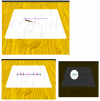Simulating hemispatial neglect with virtual reality
- PMID: 17640377
- PMCID: PMC1965467
- DOI: 10.1186/1743-0003-4-27
Simulating hemispatial neglect with virtual reality
Abstract
Background: Hemispatial neglect is a cognitive disorder defined as a lack of attention for stimuli contra-lateral to the brain lesion. The assessment is traditionally done with basic pencil and paper tests and the rehabilitation programs are generally not well adapted. We propose a virtual reality system featuring an eye-tracking device for a better characterization of the neglect that will lead to new rehabilitation techniques.
Methods: This paper presents a comparison of eye-gaze patterns of healthy subjects, patients and healthy simulated patients on a virtual line bisection test. The task was also executed with a reduced visual field condition hoping that fewer stimuli would limit the neglect.
Results: We found that patients and healthy simulated patients had similar eye-gaze patterns. However, while the reduced visual field condition had no effect on the healthy simulated patients, it actually had a negative impact on the patients. We discuss the reasons for these differences and how they relate to the limitations of the neglect simulation.
Conclusion: We argue that with some improvements the technique could be used to determine the potential of new rehabilitation techniques and also help the rehabilitation staff or the patient's relatives to better understand the neglect condition.
Figures






Similar articles
-
Diagnosis and rehabilitation of hemispatial neglect patients with virtual reality technology.Technol Health Care. 2005;13(4):245-60. Technol Health Care. 2005. PMID: 16055973
-
Virtual reality pencil and paper tests for neglect: a protocol.Cyberpsychol Behav. 2006 Apr;9(2):192-5. doi: 10.1089/cpb.2006.9.192. Cyberpsychol Behav. 2006. PMID: 16640478
-
Assessment of visuospatial neglect in stroke patients using virtual reality: a pilot study.Int J Rehabil Res. 2009 Dec;32(4):280-6. doi: 10.1097/MRR.0b013e3283013b1c. Int J Rehabil Res. 2009. PMID: 18446089
-
Uses of virtual reality for diagnosis, rehabilitation and study of unilateral spatial neglect: review and analysis.Cyberpsychol Behav. 2009 Apr;12(2):175-81. doi: 10.1089/cpb.2008.0208. Cyberpsychol Behav. 2009. PMID: 19361298 Review.
-
Simulating unilateral neglect in normals: myth or reality?Restor Neurol Neurosci. 2006;24(4-6):419-30. Restor Neurol Neurosci. 2006. PMID: 17119315 Review.
Cited by
-
Lateral visual occlusion does not change walking trajectories.J Vis. 2018 Sep 4;18(9):11. doi: 10.1167/18.9.11. J Vis. 2018. PMID: 30208430 Free PMC article.
-
A Meta-Analysis of Line Bisection and Landmark Task Performance in Older Adults.Neuropsychol Rev. 2022 Jun;32(2):438-457. doi: 10.1007/s11065-021-09505-4. Epub 2021 Apr 22. Neuropsychol Rev. 2022. PMID: 33890188 Free PMC article. Review.
-
Exploring the Potential of Immersive Virtual Reality in the Treatment of Unilateral Spatial Neglect Due to Stroke: A Comprehensive Systematic Review.Brain Sci. 2022 Nov 20;12(11):1589. doi: 10.3390/brainsci12111589. Brain Sci. 2022. PMID: 36421913 Free PMC article. Review.
-
Immersive virtual reality gameplay detects visuospatial atypicality, including unilateral spatial neglect, following brain injury: a pilot study.J Neuroeng Rehabil. 2023 Nov 23;20(1):161. doi: 10.1186/s12984-023-01283-9. J Neuroeng Rehabil. 2023. PMID: 37996834 Free PMC article.
-
Mapping the neglected space: gradients of detection revealed by virtual reality.Neurorehabil Neural Repair. 2012 Feb;26(2):120-31. doi: 10.1177/1545968311410068. Epub 2011 Jul 11. Neurorehabil Neural Repair. 2012. PMID: 21746873 Free PMC article.
References
-
- Heilman KM, Watson RT, Valenstein E. Neglect and related disorders Clinical neuropsychology. Oxford University Press; 1985. pp. 243–250.
-
- Albert ML. A simple test of visual neglect. Neurology. 1973;23:658–664. - PubMed
-
- Binder J, Marshall R, Lazar R, Benjamin J, Mohr JP. Distinct Syndrome of Hemineglect. Archives of Neurology. 1992;49:1187–1194. - PubMed
-
- Bisiach E, Capitani E, Colombo A, Spinnler H. Halving a horizontal segment : a study on hemisphere-damaged patients with cerebral focal lesions. Archives Suisses de Neurologie, Neurochirurgie et de Psychiatrie. 1976;118:199–206. - PubMed
Publication types
MeSH terms
LinkOut - more resources
Full Text Sources

